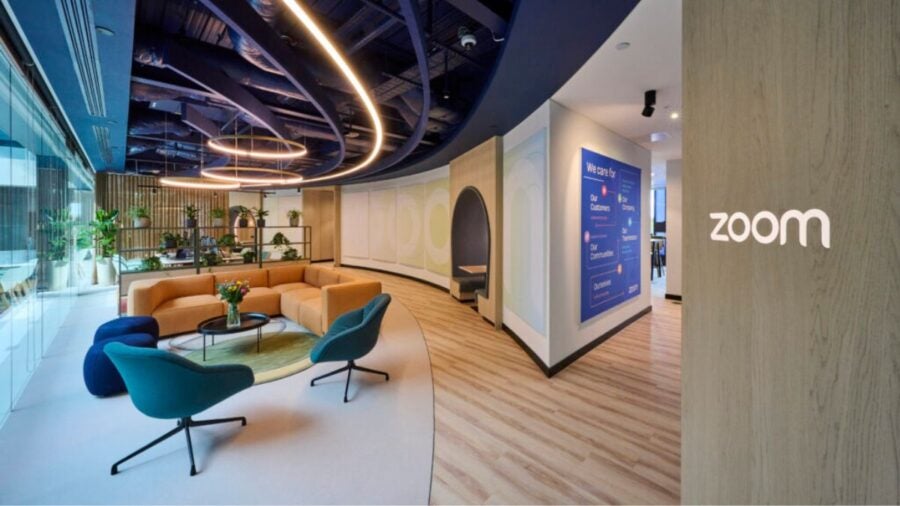
Zoom was a saviour for many organisations during the pandemic. When countries went into lockdown, the video meetings platform provided a way for businesses to continue communicating, collaborating and socialising.
Like all the pandemic’s digital darlings, the company’s market capitalisation soared over this period, as it became indispensable for almost every organisational activity. At the end of 2019, Zoom’s share price stood at $68.04 but by 16 October 2020 it had increased more than eightfold to $559.
Now, more than three years since British workers were first forced to work from home, Zoom’s share price is almost back to its pre-pandemic level ($66.06 at close on 15 August 2023) and the company faces the tough task of reinventing itself to attract new customers.
Frederik Maris, Zoom’s first head of EMEA, admits that the company probably grew “too quickly” during the pandemic. “We went from revenues of a few hundred million dollars to more than $4bn in two years,” he says. “That’s insane growth and it happened because we were in the right place at the right moment in time.”
Why is Zoom asking staff to work from the office?
Underscoring Zoom’s need to change is its recent decision to request that workers come back to the office two days a week. The change in workplace policy was picked up by a number of news outlets, which saw it as somewhat ironic that the business that first facilitated the shift to remote working was now asking people to come into the office. It has been seen as a sign by many that the work-from-home era is coming to an end.
“Certainly a year ago you would say that,” Maris says. “But because the world is becoming more hybrid, it’s increasingly important for us to experience what it is to be hybrid too. The better we understand what it’s like to be on a virtual call with a group of people who are together physically in a meeting room, the easier it is for us to understand the needs of our customers.”

He claims that this need to develop an appreciation for the challenges hybrid organisations face means that it “makes total sense” for Zoom to be asking its employees to also work in this manner.
The changes to Zoom’s working arrangements will only have a minor impact on most employees – some staff were already being asked to come into offices once a week and the new policy only increases this to two for those living within 50 miles of an office. However, in the not-too-distant past, the company had stated that staff would be able to work remotely indefinitely.
Maris says that, although most people see the benefits, the internal response to this change has been “mixed”. He adds: “In locations where we don’t have an office, people are clamouring for us to open one.”
But the shift has not been welcomed by every employee. Maris admits that part of the Amsterdam office was initially opposed to coming into the office on a day where many of them worked individually. “I don’t think we had the correct approach there the first time around,” he adds. “We’ve changed their days and now the benefits are much clearer for everyone.”
A new London office
As part of its bid to encourage more people to embrace hybrid working, Zoom opened its new London office last week. Based in Holborn, the 15,000 square foot space is intended to provide a place for Zoom’s 200 UK employees to collaborate and work alongside colleagues. It is expected that up to 80 UK staff will frequent the new office regularly.
“People have become used to working from home and see it as a benefit, so if you want to get them back into the office, you need to make it worth their while,” Maris says.
Because the world is becoming more hybrid, it’s increasingly important for us to experience what it is to be hybrid too
He is aware that no one wants to come into an office to sit on calls all day, but believes there is a lot of value in in-person work that businesses are missing out on. “Improving employee engagement is crucial and that comes from a feeling of culture and belonging, which is far more difficult to create when you’re apart,” Maris says. “Sometimes you just want to be able to sit down and have lunch together; even the time before and after meetings can be important.”
Despite businesses, such as Amazon and Google, attempting to crack down on employees who refuse to come into the office, Maris does not foresee a return to people working five days a week in the office. “Businesses should keep in mind that a lot of the work is still going to be done virtually,” he adds.
Zoom’s business transformation
Zoom is hedging its bets on hybrid working in more ways than one. Beyond his remit leading the EMEA side of the company, Maris is also tasked with helping to shift the perception of the brand from being a remote work tool to a hybrid working communications platform.
Maris describes the fact Zoom has become synonymous with remote meetings as “a blessing and a curse”. “Everybody knows us, but everybody knows us for meetings,” he says. “We’re launching many new products for the hybrid world but making the transition to a full communications platform is a lot of work.”
In order to change public perception, Zoom will be shifting from its current focus on selling a single product to promoting Zoom’s full platform.
It’s both a blessing and a curse that everyone knows Zoom for meetings
“Making that transition from a single-product company to something that will hopefully be a lot bigger, requires you to develop that market and build your strategy. That’s part of the fun,” Maris says. “It’s the same problem a startup faces – you’ve got a cool product but nobody knows about it yet.”
Among the new features Zoom is looking to promote are its business phone product Zoom Phone; Zoom IQ, a conversational AI solution for salespeople; and Workvivo, an employee engagement platform, which Zoom acquired in April this year. “We really want to become that platform for limitless collaboration,” Maris says.
Maris acknowledges that the transition will be challenging – “this is probably the most difficult phase from a growth perspective,” he adds. However, the business is relying on finding new areas for growth in order to avoid a repeat of the layoffs it announced at the start of 2023, when 15% of its total workforce was cut.
Despite the company’s growth remaining relatively flat this year, Maris is confident Zoom won’t have to enforce further redundancies any time soon. He says: “If we can find growth again, then we’ll have succeeded in our goals. If that happens, we will need all hands on deck – and a lot more people as well.”

Zoom was a saviour for many organisations during the pandemic. When countries went into lockdown, the video meetings platform provided a way for businesses to continue communicating, collaborating and socialising.
Like all the pandemic’s digital darlings, the company’s market capitalisation soared over this period, as it became indispensable for almost every organisational activity. At the end of 2019, Zoom’s share price stood at $68.04 but by 16 October 2020 it had increased more than eightfold to $559.
Now, more than three years since British workers were first forced to work from home, Zoom’s share price is almost back to its pre-pandemic level ($66.06 at close on 15 August 2023) and the company faces the tough task of reinventing itself to attract new customers.





